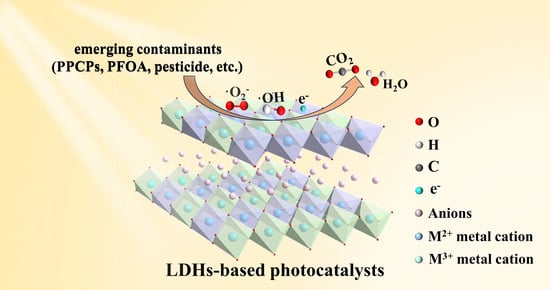Layered Double Hydroxide-Based Photocatalysts for the Removal of Emerging Contaminants: Progress in Past Ten Years
Abstract
:1. Introduction
2. Fundamental Principles of Photocatalysis
3. Pure-Phase LDHs
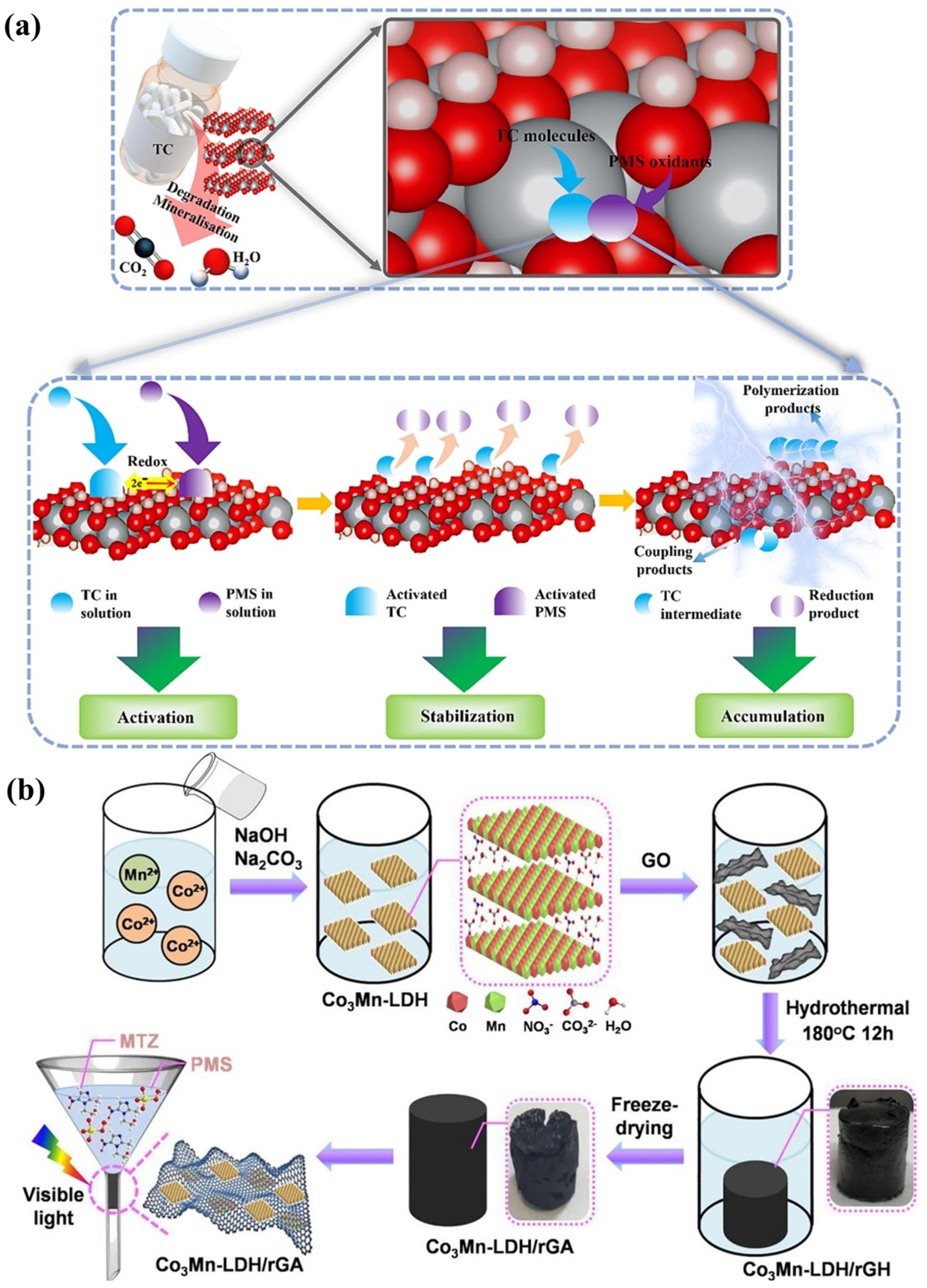
4. Interlayer-Modified LDHs
5. LDH-Based Composites
6. Layered Double Oxides (LDOs)
7. LDH-Based Photocatalysts for Oxidative Degradation of Emerging Contaminants
7.1. Photocatalytic Degradation of PPCPs
7.2. Photocatalytic Degradation of Perfluorooctanoic Acid (PFOA)
7.3. Photocatalytic Degradation of Pesticides
7.4. Photocatalytic Segradation of Other Contaminants
8. Conclusions
Author Contributions
Funding
Data Availability Statement
Conflicts of Interest
References
- Zhan, Q.-N.; Shuai, T.-Y.; Xu, H.-M.; Zhang, Z.-J.; Li, G.-R. Recent advances in the regulation of the coordination structures and environment of single-atom catalysts for carbon dioxide reduction reaction. J. Mater. Chem. A 2023, 11, 7949–7986. [Google Scholar] [CrossRef]
- Gao, Y.; Niu, X.; Wang, M.; Li, G.; An, T. An inescapable fact: Toxicity increase during photo-driven degradation of emerging contaminants in water environments. Curr. Opin. Green Sustain. Chem. 2021, 30, 100472. [Google Scholar] [CrossRef]
- Shang, Y.; Xu, X.; Gao, B.; Wang, S.; Duan, X. Single-atom catalysis in advanced oxidation processes for environmental remediation. Chem. Soc. Rev. 2021, 50, 5281–5322. [Google Scholar] [CrossRef]
- Miklos, D.B.; Remy, C.; Jekel, M.; Linden, K.G.; Drewes, J.E.; Hubner, U. Evaluation of advanced oxidation processes for water and wastewater treatment-A critical review. Water Res. 2018, 139, 118–131. [Google Scholar] [CrossRef]
- Wang, J.; Wang, S. Reactive species in advanced oxidation processes: Formation, identification and reaction mechanism. Chem. Eng. J. 2020, 401, 126158. [Google Scholar] [CrossRef]
- Wang, L.; Zhu, Z.; Wang, F.; Qi, Y.; Zhang, W.; Wang, C. State-of-the-art and prospects of Zn-containing layered double hydroxides (Zn-LDH)-based materials for photocatalytic water remediation. Chemosphere 2021, 278, 130367. [Google Scholar] [CrossRef]
- Wang, C.; Shi, P.; Wang, Z.; Guo, R.; You, J.; Zhang, H. Efficient wastewater disinfection through FeOOH-mediated photo-Fenton reaction: A review. J. Environ. Chem. Eng. 2023, 11, 111269. [Google Scholar] [CrossRef]
- Wang, Y.; Zhang, M.; Liu, Y.; Zheng, Z.; Liu, B.; Chen, M.; Guan, G.; Yan, K. Recent advances on transition-metal-based layered double hydroxides nanosheets for electrocatalytic energy conversion. Adv. Sci. 2023, 10, 2207519. [Google Scholar] [CrossRef]
- Yu, J.; Yu, F.; Yuen, M.-F.; Wang, C. Two-dimensional layered double hydroxides as a platform for electrocatalytic oxygen evolution. J. Mater. Chem. A 2021, 9, 9389–9430. [Google Scholar] [CrossRef]
- Zhu, Z.; Wang, L.; Zhang, W.; Hou, C.; Wang, C.; Zhao, J. Ultrathin CuNi2Al-LDH nanosheets with enhanced electron transfer for visible-light-driven photo-Fenton-like water decontamination. Chem. Eng. J. 2024, 481, 148313. [Google Scholar] [CrossRef]
- Li, C.; Wei, M.; Evans, D.G.; Duan, X. Layered double hydroxide-based nanomaterials as highly efficient catalysts and adsorbents. Small 2014, 10, 4469–4486. [Google Scholar] [CrossRef]
- Zhang, G.; Zhang, X.; Meng, Y.; Pan, G.; Ni, Z.; Xia, S. Layered double hydroxides-based photocatalysts and visible-light driven photodegradation of organic pollutants: A review. Chem. Eng. J. 2020, 392, 123684. [Google Scholar] [CrossRef]
- Prestopino, G.; Pezzilli, R.; Calavita, N.J.; Leonardi, C.; Falconi, C.; Medaglia, P.G. Layered-Double-Hydroxide (LDH) pyroelectric nanogenerators. Nano Energy 2023, 118, 109017. [Google Scholar] [CrossRef]
- Veeralingam, S.; Gunasekaran, S.S.; Badhulika, S. Bifunctional NiFe LDH as a piezoelectric nanogenerator and asymmetric pseudo-supercapacitor. Mater. Chem. Front. 2022, 6, 2297–2308. [Google Scholar] [CrossRef]
- Zhang, Q.; Zhang, G.; Huang, Y.; He, S.; Li, Y.; Jin, L.; Han, J. Surface-modified LDH nanosheets with high dispersibility in oil for friction and wear reduction. ACS Appl. Mater. Interfaces 2024, 16, 5316–5325. [Google Scholar] [CrossRef]
- Mohapatra, L.; Parida, K. A review on the recent progress, challenges and perspective of layered double hydroxides as promising photocatalysts. J. Mater. Chem. A 2016, 4, 10744–10766. [Google Scholar] [CrossRef]
- ten Elshof, J.E.; Yuan, H.; Gonzalez Rodriguez, P. Two-dimensional metal oxide and metal hydroxide nanosheets: Synthesis, controlled assembly and applications in energy conversion and storage. Adv. Energy Mater. 2016, 6, 1600355. [Google Scholar] [CrossRef]
- Varadwaj, G.B.B.; Oyetade, O.A.; Rana, S.; Martincigh, B.S.; Jonnalagadda, S.B.; Nyamori, V.O. Facile synthesis of three-dimensional Mg–Al layered double hydroxide/partially reduced graphene oxide nanocomposites for the effective removal of Pb2+ from aqueous solution. ACS Appl. Mater. Interfaces 2017, 9, 17290–17305. [Google Scholar] [CrossRef]
- Nayak, S.; Kumar Das, K.; Parida, K. Indulgent of the physiochemical features of MgCr-LDH nanosheets towards photodegradation process of methylene blue. J. Colloid Interface Sci. 2023, 634, 121–137. [Google Scholar] [CrossRef]
- Wang, Q.; O’Hare, D. Recent advances in the synthesis and application of layered double hydroxide (LDH) nanosheets. Chem. Rev. 2012, 112, 4124–4155. [Google Scholar] [CrossRef]
- Goh, K.-H.; Lim, T.-T.; Dong, Z. Application of layered double hydroxides for removal of oxyanions: A review. Water Res. 2008, 42, 1343–1368. [Google Scholar] [CrossRef]
- Pan, Y.; Du, J.; Chen, J.; Lian, C.; Lin, S.; Yu, J. Interlayer intercalation of Li/Al-LDHs responsible for high-efficiency boron extraction. Desalination 2022, 539, 115966. [Google Scholar] [CrossRef]
- Xu, J.; Li, Q.; Liu, X.; Yang, Q. P-doped nanorod MoO3 and nanoflower NiAl-LDH construct S-type heterojunction for photocatalytic high-efficiency hydrogen evolution. Surf. Interfaces 2023, 43, 103593. [Google Scholar] [CrossRef]
- Liu, P.F.; Yang, S.; Zhang, B.; Yang, H.G. Defect-rich ultrathin cobalt–iron layered double hydroxide for electrochemical overall water splitting. ACS Appl. Mater. Interfaces 2016, 8, 34474–34481. [Google Scholar] [CrossRef]
- Xu, J.; Liu, X.; Zhou, Z.; Deng, L.; Liu, L.; Xu, M. Surface defects introduced by metal doping into layered double hydroxide for CO2 photoreduction: The effect of metal species in light absorption, charge transfer and CO2 reduction. Chem. Eng. J. 2022, 442, 136148. [Google Scholar] [CrossRef]
- Zhao, Y.; Jia, X.; Chen, G.; Shang, L.; Waterhouse, G.I.; Wu, L.-Z.; Tung, C.-H.; O’Hare, D.; Zhang, T. Ultrafine NiO nanosheets stabilized by TiO2 from monolayer NiTi-LDH precursors: An active water oxidation electrocatalyst. J. Am. Chem. Soc. 2016, 138, 6517–6524. [Google Scholar] [CrossRef]
- Dvininov, E.; Ignat, M.; Barvinschi, P.; Smithers, M.; Popovici, E. New SnO2/MgAl-layered double hydroxide composites as photocatalysts for cationic dyes bleaching. J. Hazard. Mater. 2010, 177, 150–158. [Google Scholar] [CrossRef]
- Liang, W.; Zhang, X.; Wang, C.; Bai, J.; Li, X.; Mao, Y.; Cai, J.; Li, Y.; Chang, S.; Xu, Z.; et al. Visible-light-driven tetracycline hydrochloride degradation via ZnTi-LDHs/Ce2S3 Z-scheme heterojunctions: Performance and mechanistic analysis. J. Environ. Chem. Eng. 2024, 12, 111997. [Google Scholar] [CrossRef]
- Ali Khan, A.; Tahir, M.; Khan, N. LDH-based nanomaterials for photocatalytic applications: A comprehensive review on the role of bi/trivalent cations, anions, morphology, defect engineering, memory effect, and heterojunction formation. J. Energy Chem. 2023, 84, 242–276. [Google Scholar] [CrossRef]
- Sun, H.; Heo, Y.-J.; Park, J.-H.; Rhee, K.Y.; Park, S.-J. Advances in layered double hydroxide-based ternary nanocomposites for photocatalysis of contaminants in water. Nanotechnol. Rev. 2020, 9, 1381–1396. [Google Scholar] [CrossRef]
- Cao, Y.; Zheng, D.; Zhang, F.; Pan, J.; Lin, C. Layered double hydroxide (LDH) for multi-functionalized corrosion protection of metals: A review. J. Mater. Sci. Technol. 2022, 102, 232–263. [Google Scholar] [CrossRef]
- Rauf, M.A.; Ashraf, S.S. Fundamental principles and application of heterogeneous photocatalytic degradation of dyes in solution. Chem. Eng. J. 2009, 151, 10–18. [Google Scholar] [CrossRef]
- Bian, X.; Zhang, S.; Zhao, Y.; Shi, R.; Zhang, T. Layered double hydroxide-based photocatalytic materials toward renewable solar fuels production. InfoMat 2021, 3, 719–738. [Google Scholar] [CrossRef]
- Feng, H.; Yu, J.; Tang, L.; Wang, J.; Dong, H.; Ni, T.; Tang, J.; Tang, W.; Zhu, X.; Liang, C. Improved hydrogen evolution activity of layered double hydroxide by optimizing the electronic structure. Appl. Catal. B Environ. 2021, 297, 120478. [Google Scholar] [CrossRef]
- Mohapatra, L.; Parida, K.M. Dramatic activities of vanadate intercalated bismuth doped LDH for solar light photocatalysis. Phys. Chem. Chem. Phys. 2014, 16, 16985–16996. [Google Scholar] [CrossRef] [PubMed]
- Luo, J.; Li, W.; Yin, R.; Liu, Q.; Xin, X.; Yang, L.; He, K.; Ma, D.; Lv, S.; Xing, D. Photocatalyst degradation of perfluorooctanoic acid in water: Mechanisms, approaches, and perspectives. Sep. Purif. Technol. 2024, 338, 126503. [Google Scholar] [CrossRef]
- Boumeriame, H.; Da Silva, E.S.; Cherevan, A.S.; Chafik, T.; Faria, J.L.; Eder, D. Layered double hydroxide (LDH)-based materials: A mini-review on strategies to improve the performance for photocatalytic water splitting. J. Energy Chem. 2022, 64, 406–431. [Google Scholar] [CrossRef]
- Zou, J.; Wang, Z.; Guo, W.; Guo, B.; Yu, Y.; Wu, L. Photocatalytic selective oxidation of benzyl alcohol over ZnTi-LDH: The effect of surface OH groups. Appl. Catal. B Environ. 2020, 260, 118185. [Google Scholar] [CrossRef]
- Guru, S.; Kumar, S.; Bellamkonda, S.; Gangavarapu, R.R. Synthesis of CuTi-LDH supported on g-C3N4 for electrochemical and photoelectrochemical oxygen evolution reactions. Int. J. Hydrogen Energy 2021, 46, 16414–16430. [Google Scholar] [CrossRef]
- He, W.; Jia, H.; Wamer, W.G.; Zheng, Z.; Li, P.; Callahan, J.H.; Yin, J.-J. Predicting and identifying reactive oxygen species and electrons for photocatalytic metal sulfide micro–nano structures. J. Catal. 2014, 320, 97–105. [Google Scholar] [CrossRef]
- Li, Y.; Zhang, W.; Niu, J.; Chen, Y. Mechanism of photogenerated reactive oxygen species and correlation with the antibacterial properties of engineered metal-oxide nanoparticles. ACS Nano 2012, 6, 5164–5173. [Google Scholar] [CrossRef]
- Morales-Mendoza, G.; Tzompantzi, F.; García-Mendoza, C.; López, R.; De la Luz, V.; Lee, S.-W.; Kim, T.-H.; Torres-Martínez, L.M.; Gómez, R. Mn-doped Zn/Al layered double hydroxides as photocatalysts for the 4-chlorophenol photodegradation. Appl. Clay Sci. 2015, 118, 38–47. [Google Scholar] [CrossRef]
- Li, Z.; Zhang, Q.; Liu, X.; Wu, L.; Hu, H.; Zhao, Y. One-step mechanochemical synthesis of plasmonic Ag/Zn–Al LDH with excellent photocatalytic activity. J. Mater. Sci. 2018, 53, 12795–12806. [Google Scholar] [CrossRef]
- Dang, R.; Ma, X.; Liu, J.; Yan, L.; Gao, W.; Li, J.; Chen, B. Preparation of Zn2+–Ni2+–Fe3+–CO32−LDHs and study of photocatalytic activities for decomposition of Methyl Orange solution. Compos. Interfaces 2016, 24, 1–11. [Google Scholar] [CrossRef]
- Hosni, K.; Abdelkarim, O.; Frini-Srasra, N.; Srasra, E. Synthesis, structure and photocatalytic activity of calcined Mg-Al-Ti-layered double hydroxides. Korean J. Chem. Eng. 2014, 32, 104–112. [Google Scholar] [CrossRef]
- Mancipe, S.; Tzompantzi, F.; Rojas, H.; Gómez, R. Photocatalytic degradation of phenol using MgAlSn hydrotalcite-like compounds. Appl. Clay Sci. 2016, 129, 71–78. [Google Scholar] [CrossRef]
- Roy Chowdhury, P.; Bhattacharyya, K.G. Synthesis and characterization of Mn/Co/Ti LDH and its utilization as a photocatalyst in visible light assisted degradation of aqueous Rhodamine B. RSC Adv. 2016, 6, 112016–112034. [Google Scholar] [CrossRef]
- Asif, M.; Saeed, M.; Zafar, M.; Amjad, U.-e.-S.; Razzaq, A.; Kim, W.Y. Development of Co-Al LDH/GO composite photocatalyst for enhanced degradation of textile pollutant under visible light irradiation. Results Phys. 2022, 42, 105997. [Google Scholar] [CrossRef]
- Kaur, H.; Singh, S.; Pal, B. Construction of Ag deposited g-C3N4 loaded Co Al LDH ternary composites with aim of pharmaceutical wastewater treatment: Pathways and mechanism for ciprofloxacin degradation. Appl. Clay Sci. 2023, 238, 106922. [Google Scholar] [CrossRef]
- Chowdhury, P.R.; Medhi, H.; Verma, V.; Kalita, C.; Bhattacharyya, K.G.; Hussain, C.M. Characterisation of Mn/Ti layered double hydroxide for methylene blue degradation with Bayesian representation of electron transport. Mater. Today Commun. 2022, 33, 104859. [Google Scholar] [CrossRef]
- Dinari, M.; Momeni, M.M.; Ghayeb, Y. Photodegradation of organic dye by ZnCrLa-layered double hydroxide as visible-light photocatalysts. J. Mater. Sci. Mater. Electron. 2016, 27, 9861–9869. [Google Scholar] [CrossRef]
- Chen, G.; Qian, S.; Tu, X.; Wei, X.; Zou, J.; Leng, L.; Luo, S. Enhancement photocatalytic degradation of rhodamine B on nanoPt intercalated Zn–Ti layered double hydroxides. Appl. Surf. Sci. 2014, 293, 345–351. [Google Scholar] [CrossRef]
- Wu, L.; Hu, J.; Sun, C.; Jiao, F. Construction of Z-scheme CoAl-LDH/Bi2MoO6 heterojunction for enhanced photocatalytic degradation of antibiotics in natural water bodies. Process Saf. Environ. 2022, 168, 1109–1119. [Google Scholar] [CrossRef]
- Zeng, H.; Zhang, H.; Deng, L.; Shi, Z. Peroxymonosulfate-assisted photocatalytic degradation of sulfadiazine using self-assembled multi-layered CoAl-LDH/g-C3N4 heterostructures: Performance, mechanism and eco-toxicity evaluation. J. Water Process Eng. 2020, 33, 101084. [Google Scholar] [CrossRef]
- Fazli, A.; Brigante, M.; Khataee, A.; Mailhot, G. Synthesis of a magnetically separable LDH-based S-scheme nano-heterojunction for the activation of peroxymonosulfate towards the efficient visible-light photodegradation of diethyl phthalate. Appl. Surf. Sci. 2021, 559, 149906. [Google Scholar] [CrossRef]
- Abazari, R.; Morsali, A.; Dubal, D.P. An advanced composite with ultrafast photocatalytic performance for the degradation of antibiotics by natural sunlight without oxidizing the source over TMU-5@Ni–Ti LDH: Mechanistic insight and toxicity assessment. Inorg. Chem. Front. 2020, 7, 2287–2304. [Google Scholar] [CrossRef]
- Huang, X.; Xu, X.; Yang, R.; Fu, X. Synergetic adsorption and photocatalysis performance of g-C3N4/Ce-doped MgAl-LDH in degradation of organic dye under LED visible light. Colloid. Surface A 2022, 643, 128738. [Google Scholar] [CrossRef]
- Khan, A.I.; O’Hare, D. Intercalation chemistry of layered double hydroxides: Recent developments and applications. J. Mater. Chem. 2002, 12, 3191–3198. [Google Scholar] [CrossRef]
- Weir, M.R.; Moore, J.; Kydd, R.A. Effects of pH and Mg: Ga ratio on the synthesis of gallium-containing layered double hydroxides and their polyoxometalate anion exchanged products. Chem. Mater. 1997, 9, 1686–1690. [Google Scholar] [CrossRef]
- Busetto, C.; Del Piero, G.; Manara, G.; Trifirò, F.; Vaccari, A. Catalysts for low-temperature methanol synthesis. Preparation of CuZnAl mixed oxides via hydrotalcite-like precursors. J. Catal. 1984, 85, 260–266. [Google Scholar] [CrossRef]
- Millange, F.; Walton, R.I.; O’Hare, D. Time-resolved in situ X-ray diffraction study of the liquid-phase reconstruction of Mg–Al–carbonate hydrotalcite-like compounds. J. Mater. Chem. 2000, 10, 1713–1720. [Google Scholar] [CrossRef]
- Zheng, J.; Fan, C.; Li, X.; Yang, Q.; Wang, D.; Duan, A.; Pan, S.; Gao, Y. Simultaneous tailored poly-heptazine units in ZnAl-LDH nanocatalytic surface activation of pollutants and peroxymonosulfate for highly efficient water decontamination. Chem. Eng. J. 2024, 480, 148234. [Google Scholar] [CrossRef]
- He, S.; Yin, R.; Chen, Y.; Lai, T.; Guo, W.; Zeng, L.; Zhu, M. Consolidated 3D Co3Mn-layered double hydroxide aerogel for photo-assisted peroxymonosulfate activation in metronidazole degradation. Chem. Eng. J. 2021, 423, 130172. [Google Scholar] [CrossRef]
- Yekan Motlagh, P.; Khataee, A.; Sadeghi Rad, T.; Hassani, A.; Joo, S.W. Fabrication of ZnFe-layered double hydroxides with graphene oxide for efficient visible light photocatalytic performance. J. Taiwan Inst. Chem. Eng. 2019, 101, 186–203. [Google Scholar] [CrossRef]
- Ciocarlan, R.G.; Wang, H.; Cuypers, B.; Mertens, M.; Wu, Y.; Van Doorslaer, S.; Seftel, E.M.; Cool, P. ZnTi layered double hydroxides as photocatalysts for salicylic acid degradation under visible light irradiation. Appl. Clay Sci. 2020, 197, 105757. [Google Scholar] [CrossRef]
- Chen, Q.; Wu, L.; Zhao, X.; Yang, X.-J. Fabrication of Zn-Ti layered double oxide nanosheets with ZnO/ZnTiO3 heterojunction for enhanced photocatalytic degradation of MO, RhB and MB. J. Mol. Liq. 2022, 353, 118794. [Google Scholar] [CrossRef]
- Santamaría, L.; Vicente, M.A.; Korili, S.A.; Gil, A. Saline slag waste as an aluminum source for the synthesis of Zn–Al–Fe–Ti layered double-hydroxides as catalysts for the photodegradation of emerging contaminants. J. Alloys Compd. 2020, 843, 156007. [Google Scholar] [CrossRef]
- Peng, B.; Wu, L.; Li, Q.; Wang, Q.; Li, K.; Zhou, Z. Photodegradation of naproxen using CuZnAl-layered double hydroxides as photocatalysts. CrystEngComm 2022, 24, 5080–5089. [Google Scholar] [CrossRef]
- Zhou, H.; Zhang, Y. Efficient thermal and photocatalysts made of Au nanoparticles on MgAl-layered double hydroxides for energy and environmental applications. PCCP 2019, 21, 21798–21805. [Google Scholar] [CrossRef]
- Mkaddem, H.; Rosales, E.; Pazos, M.; Ben Amor, H.; Sanromán, M.A.; Meijide, J. Anti-inflammatory drug diclofenac removal by a synthesized MgAl layered double hydroxide. J. Mol. Liq. 2022, 359, 119207. [Google Scholar] [CrossRef]
- Rashidimoghaddam, M.; Saljooqi, A.; Shamspur, T.; Mostafavi, A. Constructing S-doped Ni–Co LDH intercalated with Fe3O4 heterostructure photocatalysts for enhanced pesticide degradation. New J. Chem. 2020, 44, 15584–15592. [Google Scholar] [CrossRef]
- Fang, D.; Huang, L.; Fan, J.; Xiao, H.; Wu, G.; Wang, Y.; Zeng, Z.; Shen, F.; Deng, S.; Ji, F. New insights into the arrangement pattern of layered double hydroxide nanosheets and their ion-exchange behavior with phosphate. Chem. Eng. J. 2022, 441, 136057. [Google Scholar] [CrossRef]
- Li, L.; Ma, R.; Ebina, Y.; Iyi, N.; Sasaki, T. Positively charged nanosheets derived via total delamination of layered double hydroxides. Chem. Mater. 2005, 17, 4386–4391. [Google Scholar] [CrossRef]
- Chen, B.Q.; Xia, H.Y.; Mende, L.K.; Lee, C.H.; Wang, S.B.; Chen, A.Z.; Xu, Z.P.; Kankala, R.K. Trends in layered double hydroxides-based advanced nanocomposites: Recent progress and latest advancements. Adv. Mater. Interfaces 2022, 9, 2200373. [Google Scholar] [CrossRef]
- Taviot-Guého, C.; Prévot, V.; Forano, C.; Renaudin, G.; Mousty, C.; Leroux, F. Tailoring hybrid layered double hydroxides for the development of innovative applications. Adv. Funct. Mater. 2017, 28, 1703868. [Google Scholar] [CrossRef]
- Venkateshalu, S.; Tomboc, G.M.; Nagalingam, S.P.; Kim, J.; Sawaira, T.; Sehar, K.; Pollet, B.G.; Kim, J.Y.; Nirmala Grace, A.; Lee, K. Synergistic MXene/LDH heterostructures with extensive interfacing as emerging energy conversion and storage materials. J. Mater. Chem. A 2023, 11, 14469–14488. [Google Scholar] [CrossRef]
- Elhalil, A.; Elmoubarki, R.; Sadiq, M.h.; Abdennouri, M.; Kadmi, Y.; Favier, L.; Qourzal, S.; Barka, N. Enhanced photocatalytic degradation of caffeine as a model pharmaceutical pollutant by Ag-ZnO-Al2O3 nanocomposite. Desalin. Water Treat. 2017, 94, 254–262. [Google Scholar] [CrossRef]
- Zhang, Z.; Zhao, H.; Ma, X.; Zhang, N.; Meng, Z.; Wang, Y.; Zhao, M.; Liu, H.; Zhang, Q. Construction of MoS42− intercalated NiAl-layered double hydroxide by solvent-free method for promoting photocatalytic degradation of antibiotics: Synergistic effect of oxygen vacancies and electron-rich groups. Sep. Purif. Technol. 2024, 337, 126388. [Google Scholar] [CrossRef]
- Liu, Y.; Tang, C.; Cheng, M.; Chen, M.; Chen, S.; Lei, L.; Chen, Y.; Yi, H.; Fu, Y.; Li, L. Polyoxometalate@Metal–Organic framework composites as effective photocatalysts. ACS Catal. 2021, 11, 13374–13396. [Google Scholar] [CrossRef]
- Chang, W.; Qi, B.; Song, Y.-F. Step-by-step assembly of 2D confined chiral space endowing achiral clusters with asymmetric catalytic activity for epoxidation of allylic alcohols. ACS Appl. Mater. Interfaces 2020, 12, 36389–36397. [Google Scholar] [CrossRef]
- Guo, Y.; Li, D.; Hu, C.; Wang, Y.; Wang, E. Layered double hydroxides pillared by tungsten polyoxometalates: Synthesis and photocatalytic activity. Int. J. Inorg. Mater. 2001, 3, 347–355. [Google Scholar] [CrossRef]
- Huang, F.; Tian, S.; Qi, Y.; Li, E.; Zhou, L.; Qiu, Y. Synthesis of FePcS–PMA–LDH cointercalation composite with enhanced visible light photo-Fenton catalytic activity for BPA degradation at circumneutral pH. Materials 2020, 13, 1951. [Google Scholar] [CrossRef] [PubMed]
- Guo, Y.; Li, D.; Hu, C.; Wang, E.; Zou, Y.; Ding, H.; Feng, S. Preparation and photocatalytic behavior of Zn/Al/W(Mn) mixed oxides via polyoxometalates intercalated layered double hydroxides. Microporous Mesoporous Mater. 2002, 56, 153–162. [Google Scholar] [CrossRef]
- Tang, X.; Liu, Y.; Li, S. Heterogeneous UV-Fenton photodegradation of azocarmine B over [FeEDTA]− intercalated ZnAl-LDH at circumneutral pH. RSC Adv. 2016, 6, 80501–80510. [Google Scholar] [CrossRef]
- Wu, J.; Cai, Y.; Zhang, M.; Zhou, J.; Zhou, X.; Shu, W.; Zhang, J.; Huang, X.; Qian, G.; Deng, Y. Enhancing oxidative capability of Ferrate(VI) for oxidative destruction of phenol in water through intercalation of Ferrate(VI) into layered double hydroxide. Appl. Clay Sci. 2019, 171, 48–56. [Google Scholar] [CrossRef]
- Sherryna, A.; Tahir, M.; Nabgan, W. Recent advancements of layered double hydroxide heterojunction composites with engineering approach towards photocatalytic hydrogen production: A review. Int. J. Hydrog. Energy 2022, 47, 862–901. [Google Scholar] [CrossRef]
- Pelalak, R.; Hassani, A.; Heidari, Z.; Zhou, M. State-of-the-art recent applications of layered double hydroxides (LDHs) material in Fenton-based oxidation processes for water and wastewater treatment. Chem. Eng. J. 2023, 474, 145511. [Google Scholar] [CrossRef]
- Ijaz, M.; Zafar, M. Titanium dioxide nanostructures as efficient photocatalyst: Progress, challenges and perspective. Int. J. Energ. Res. 2020, 45, 3569–3589. [Google Scholar] [CrossRef]
- Ali, I.; Suhail, M.; Alothman, Z.A.; Alwarthan, A. Recent advances in syntheses, properties and applications of TiO2 nanostructures. RSC Adv. 2018, 8, 30125–30147. [Google Scholar] [CrossRef]
- Suh, M.-J.; Shen, Y.; Chan, C.K.; Kim, J.-H. Titanium dioxide–layered double hydroxide composite material for adsorption–photocatalysis of water pollutants. Langmuir 2019, 35, 8699–8708. [Google Scholar] [CrossRef]
- Grzegórska, A.; Wysocka, I.; Głuchowski, P.; Ryl, J.; Karczewski, J.; Zielińska-Jurek, A. Novel composite of Zn/Ti-layered double hydroxide coupled with MXene for the efficient photocatalytic degradation of pharmaceuticals. Chemosphere 2022, 308, 136191. [Google Scholar] [CrossRef]
- Omrani, E.; Ahmadpour, A.; Heravi, M.; Bastami, T.R. Novel ZnTi LDH/h-BN nanocomposites for removal of two different organic contaminants: Simultaneous visible light photodegradation of Amaranth and Diazepam. J. Water Process Eng. 2022, 47, 102581. [Google Scholar] [CrossRef]
- Liu, Z.; Duan, X.; Sarmah, A.K.; Zhao, X.; Ren, X.; Sun, B. A novel 3-dimensional graphene-based cobalt-manganese bimetallic layered double hydroxide: Formation mechanism and performance in photo-assisted permonosulfate-activated degradation of sulfamethoxazole in aqueous solution. Environ. Pollut. 2023, 336, 122397. [Google Scholar] [CrossRef] [PubMed]
- Yu, Y.; Chen, D.; Xu, W.; Fang, J.; Sun, J.; Liu, Z.; Chen, Y.; Liang, Y.; Fang, Z. Synergistic adsorption-photocatalytic degradation of different antibiotics in seawater by a porous g-C3N4/calcined-LDH and its application in synthetic mariculture wastewater. J. Hazard. Mater. 2021, 416, 126183. [Google Scholar] [CrossRef] [PubMed]
- Gholami, P.; Khataee, A.; Soltani, R.D.C.; Dinpazhoh, L.; Bhatnagar, A. Photocatalytic degradation of gemifloxacin antibiotic using Zn-Co-LDH@biochar nanocomposite. J. Hazard. Mater. 2020, 382, 121070. [Google Scholar] [CrossRef]
- Wu, Y.; Wang, H.; Sun, Y.; Xiao, T.; Tu, W.; Yuan, X.; Zeng, G.; Li, S.; Chew, J.W. Photogenerated charge transfer via interfacial internal electric field for significantly improved photocatalysis in direct Z-scheme oxygen-doped carbon nitrogen/CoAl-layered double hydroxide heterojunction. Appl. Catal. B Environ. 2018, 227, 530–540. [Google Scholar] [CrossRef]
- Sun, Y.; Wang, L.; Wang, T.; Liu, X.; Xu, T.; Wei, M.; Yang, L.; Li, C. Improved photocatalytic activity of Ni2P/NiCo-LDH composites via a Co–P bond charge transfer channel to degrade tetracycline under visible light. J. Alloys Compd. 2021, 852, 156963. [Google Scholar] [CrossRef]
- Zhang, D.; Ji, T.; Yu, J.; Jiang, X.; Jiao, F. Solvothermal synthesis of Cs0.33WO3/LDHs composite as a novel visible-light-driven photocatalyst. Photochem. Photobiol. 2018, 94, 219–227. [Google Scholar] [CrossRef]
- Zhou, Q.; Jiang, B.; Zhang, L.; Sun, Y.; Yang, X.; Zhang, L. 1D/2D CoNi-LDH/ZnIn2S4 S-scheme heterojunction for effectively tetracycline degradation under photocatalytic-peroxymonosulfate activation system: DFT calculations and mechanism insights. Chem. Eng. J. 2023, 478, 147535. [Google Scholar] [CrossRef]
- Ye, C.; Deng, J.; Huai, L.; Cai, A.; Ling, X.; Guo, H.; Wang, Q.; Li, X. Multifunctional capacity of CoMnFe-LDH/LDO activated peroxymonosulfate for p-arsanilic acid removal and inorganic arsenic immobilization: Performance and surface-bound radical mechanism. Sci. Total Environ. 2022, 806, 150379. [Google Scholar] [CrossRef]
- Hou, X.; Liu, S.; Yu, C.; Jiang, L.; Zhang, Y.; Liu, G.; Zhou, C.; Zhu, T.; Xin, Y.; Yan, Q. A novel magnetic CuFeAl-LDO catalyst for efficient degradation of tetrabromobisphenol a in water. Chem. Eng. J. 2022, 430, 133107. [Google Scholar] [CrossRef]
- Chen, M.; Li, S.; Li, L.; Jiang, L.; Ahmed, Z.; Dang, Z.; Wu, P. Memory effect induced the enhancement of uranium (VI) immobilization on low-cost MgAl-double oxide: Mechanism insight and resources recovery. J. Hazard. Mater. 2021, 401, 123447. [Google Scholar] [CrossRef] [PubMed]
- Shen, J.-C.; Zeng, H.-Y.; Chen, C.-R.; Xu, S. A facile fabrication of Ag2O-Ag/ZnAl-oxides with enhanced visible-light photocatalytic performance for tetracycline degradation. Appl. Clay Sci. 2020, 185, 105413. [Google Scholar] [CrossRef]
- Feng, X.; Yu, Z.; Shan, M.; Long, R.; Li, X.; Liao, K. Z-type ZnAl-LDO/Ag2S heterojunction activated peroxysulfate to degrade tetracycline hydrochloride under visible light efficiently. Chem. Eng. J. 2022, 443, 136422. [Google Scholar] [CrossRef]
- Elhalil, A.; Elmoubarki, R.; Machrouhi, A.; Sadiq, M.; Abdennouri, M.; Qourzal, S.; Barka, N. Photocatalytic degradation of caffeine by ZnO-ZnAl2O4 nanoparticles derived from LDH structure. J. Environ. Chem. Eng. 2017, 5, 3719–3726. [Google Scholar] [CrossRef]
- Zheng, X.; Dong, Y.; Zhu, Q. Enhanced photocatalysis of MgAl layered double oxide nanosheets with B, N-codoped carbon coating for tetracycline removal. Appl. Clay Sci. 2020, 193, 105694. [Google Scholar] [CrossRef]
- Zhang, J.; Gao, M.; Wang, R.; Li, X.; Wang, J.; Li, S.; Cao, K.; Li, J.; Wang, Y.; Zheng, Z. Bifunctional role of oxygen vacancy in LDH supported Au nanoparticles catalyst for selective photocatalytic hydrogenation of cinnamaldehyde. Fuel 2024, 365, 131235. [Google Scholar] [CrossRef]
- Azalok, K.A.; Oladipo, A.A.; Gazi, M. Hybrid MnFe-LDO–biochar nanopowders for degradation of metronidazole via UV-light-driven photocatalysis: Characterization and mechanism studies. Chemosphere 2021, 268, 128844. [Google Scholar] [CrossRef] [PubMed]
- Azalok, K.A.; Oladipo, A.A.; Gazi, M. UV-light-induced photocatalytic performance of reusable MnFe-LDO–biochar for tetracycline removal in water. J. Photoch. Photobio. A 2021, 405, 112976. [Google Scholar] [CrossRef]
- Gao, K.; Huang, D.; Hou, L.-a.; An, X.; Takizawa, S.; Yang, Y. Efficient degradation of carbamazepine by sulfate doped LDO/CN in the photo-assisted peroxymonosulfate system. Chem. Eng. J. 2024, 482, 149034. [Google Scholar] [CrossRef]
- Di, G.; Zhu, Z.; Zhang, H.; Zhu, J.; Lu, H.; Zhang, W.; Qiu, Y.; Zhu, L.; Küppers, S. Simultaneous removal of several pharmaceuticals and arsenic on Zn-Fe mixed metal oxides: Combination of photocatalysis and adsorption. Chem. Eng. J. 2017, 328, 141–151. [Google Scholar] [CrossRef]
- Elhalil, A.; Elmoubarki, R.; Farnane, M.; Machrouhi, A.; Mahjoubi, F.Z.; Sadiq, M.; Qourzal, S.; Barka, N. Synthesis, characterization and efficient photocatalytic activity of novel Ca/ZnO-Al2O3 nanomaterial. Mater. Today Commun. 2018, 16, 194–203. [Google Scholar] [CrossRef]
- Wang, M.; Wang, J.; Li, M.; Wang, X.; Sima, Y.; Wu, Q. Novel In2S3/Zn–Al LDHs composite as an efficient visible-light-driven photocatalyst for tetracycline degradation. Opt. Mater. 2022, 128, 112376. [Google Scholar] [CrossRef]
- Li, X.; Ma, T.; Dong, L.; Na, Y.; Liu, Y.; Li, Z.; Zheng, R.; Dai, S.; Zhao, T. Mechanochemical homodisperse of Bi2MoO6 on Zn-Al LDH matrix to form Z-scheme heterojunction with promoted visible-light photocatalytic performance. Adv. Powder Technol. 2022, 33, 103468. [Google Scholar] [CrossRef]
- Zhang, H.; Nengzi, L.-c.; Wang, Z.; Zhang, X.; Li, B.; Cheng, X. Construction of Bi2O3/CuNiFe LDHs composite and its enhanced photocatalytic degradation of lomefloxacin with persulfate under simulated sunlight. J. Hazard. Mater. 2020, 383, 121236. [Google Scholar] [CrossRef] [PubMed]
- Li, Q.; Wei, G.; Duan, G.; Zhang, L.; Li, Z.; Wei, Z.; Zhou, Q.; Pei, R. Photocatalysis activation of peroxydisulfate over oxygen vacancies-rich mixed metal oxide derived from red mud-based layered double hydroxide for ciprofloxacin degradation. Sep. Purif. Technol. 2022, 289, 120733. [Google Scholar] [CrossRef]
- Sun, C.; Wang, Y.; Wu, L.; Hu, J.; Long, X.; Wu, H.; Jiao, F. In situ preparation of novel p–n junction photocatalyst MgAl-LDH/(BiO)2CO3 for enhanced photocatalytic degradation of tetracycline. Mater. Sci. Semicond. Process. 2022, 150, 106939. [Google Scholar] [CrossRef]
- Sadeghi Rad, T.; Khataee, A.; Arefi-Oskoui, S.; Sadeghi Rad, S.; Orooji, Y.; Gengec, E.; Kobya, M. Graphene-based ZnCr layered double hydroxide nanocomposites as bactericidal agents with high sonophotocatalytic performances for degradation of rifampicin. Chemosphere 2022, 286, 131740. [Google Scholar] [CrossRef]
- Shen, J.; Shi, A.; Lu, J.; Lu, X.; Zhang, H.; Jiang, Z. Optimized fabrication of Cu-doped ZnO/calcined CoFe–LDH composite for efficient degradation of bisphenol a through synergistic visible-light photocatalysis and persulfate activation: Performance and mechanisms. Environ. Pollut. 2023, 323, 121186. [Google Scholar] [CrossRef] [PubMed]
- Sadeghi Rad, T.; Khataee, A.; Sadeghi Rad, S.; Arefi-Oskoui, S.; Gengec, E.; Kobya, M.; Yoon, Y. Zinc-chromium layered double hydroxides anchored on carbon nanotube and biochar for ultrasound-assisted photocatalysis of rifampicin. Ultrason. Sonochem. 2022, 82, 105875. [Google Scholar] [CrossRef]
- Sheikhpoor, H.; Saljooqi, A.; Shamspur, T.; Mostafavi, A. Co-Al Layered double hydroxides decorated with CoFe2O4 nanoparticles and g-C3N4 nanosheets for efficient photocatalytic pesticide degradation. Environ. Technol. Innov. 2021, 23, 101649. [Google Scholar] [CrossRef]
- Zheng, J.; Tang, X.; Fan, C.; Deng, Y.; Li, X.; Yang, Q.; Wang, D.; Duan, A.; Luo, J.; Chen, Z.; et al. Facile synthesis of Ag@AgCl/ZnAl-LDH sesame balls nanocomposites with enhanced photocatalytic performance for the degradation of neonicotinoid pesticides. Chem. Eng. J. 2022, 446, 136485. [Google Scholar] [CrossRef]
- Zheng, J.; Li, W.; Tang, R.; Xiong, S.; Gong, D.; Deng, Y.; Zhou, Z.; Li, L.; Su, L.; Yang, L. Ultrafast photodegradation of nitenpyram by Ag/Ag3PO4/Zn–Al LDH composites activated by persulfate system: Removal efficiency, degradation pathway and reaction mechanism. Chemosphere 2022, 292, 133431. [Google Scholar] [CrossRef] [PubMed]
- Zheng, J.; Deng, Y.; Fan, C.; Li, X.; Gong, D.; Li, C.; Ye, Z. Novel Zn-Al LDHs based S-scheme heterojunction with coral reef-like structure for photocatalytic activation of peroxymonosulfate towards nitenpyram decomposition. J. Environ. Chem. Eng. 2022, 10, 108188. [Google Scholar] [CrossRef]
- Zheng, J.; Fan, C.; Li, X.; Yang, Q.; Wang, D.; Duan, A.; Pan, S. Efficient mineralisation and disinfection of neonicotinoid pesticides with unique ZnAl-LDH intercalation structure and synergistic effect of Cu2O crystalline surface. Colloid. Surface. A 2024, 687, 133507. [Google Scholar] [CrossRef]
- Li, E.; Liao, L.; Lv, G.; Li, Z.; Yang, C.; Lu, Y. The Interactions Between Three Typical PPCPs and LDH. Front. Chem. 2018, 6, 00016. [Google Scholar] [CrossRef] [PubMed]
- Gao, Z.; Liang, J.; Yao, J.; Meng, Q.; He, G.; Chen, H. Synthesis of Ce-doped NiAl LDH/RGO composite as an efficient photocatalyst for photocatalytic degradation of ciprofloxacin. J. Environ. Chem. Eng. 2021, 9, 105405. [Google Scholar] [CrossRef]
- Mourid, E.H.; El Mouchtari, E.M.; El Mersly, L.; Benaziz, L.; Rafqah, S.; Lakraimi, M. Development of a new recyclable nanocomoposite LDH-TiO2 for the degradation of antibiotic sulfamethoxazole under UVA radiation: An approach towards sunlight. J. Photochem. Photobiol. A 2020, 396, 112530. [Google Scholar] [CrossRef]
- Arjomandi-Behzad, L.; Alinejad, Z.; Zandragh, M.R.; Golmohamadi, A.; Vojoudi, H. Facile synthesis of hollow spherical g-C3N4@LDH/NCQDs ternary nanostructure for multifunctional antibacterial and photodegradation activities. iScience 2023, 26, 106213. [Google Scholar] [CrossRef]
- Xiong, J.; Zeng, H.-Y.; Peng, J.-F.; Wang, L.-H.; Peng, D.-Y.; Liu, F.-Y.; Xu, S.; Yang, Z.-L. Fabrication of Cu2O/ZnTi-LDH p-n heterostructure by grafting Cu2O NPs onto the LDH host layers from Cu-doped ZnTi-LDH and insight into the photocatalytic mechanism. Compos. Part B Eng. 2023, 250, 110447. [Google Scholar] [CrossRef]
- Rodgers, K.M.; Swartz, C.H.; Occhialini, J.; Bassignani, P.; McCurdy, M.; Schaider, L.A. How Well Do Product Labels Indicate the Presence of PFAS in Consumer Items Used by Children and Adolescents? Environ. Sci. Technol. 2022, 56, 6294–6304. [Google Scholar] [CrossRef]
- Schulz, K.; Silva, M.R.; Klaper, R. Distribution and effects of branched versus linear isomers of PFOA, PFOS, and PFHxS: A review of recent literature. Sci. Total Environ. 2020, 733, 139186. [Google Scholar] [CrossRef] [PubMed]
- Michaels, R.A. Lessons learned from legacy contaminants of emerging concern: Perfluoroalkyl compounds (PFCs) in the village of hoosick falls, rensselaer county, New York. Environ. Claims J. 2017, 29, 4–48. [Google Scholar] [CrossRef]
- Tang, H.; Zhang, W.; Meng, Y.; Xia, S. A direct Z-scheme heterojunction with boosted transportation of photogenerated charge carriers for highly efficient photodegradation of PFOA: Reaction kinetics and mechanism. Appl. Catal. B Environ. 2021, 285, 119851. [Google Scholar] [CrossRef]
- Yang, Y.; Ji, W.; Li, X.; Zheng, Z.; Bi, F.; Yang, M.; Xu, J.; Zhang, X. Insights into the degradation mechanism of perfluorooctanoic acid under visible-light irradiation through fabricating flower-shaped Bi5O7I/ZnO n-n heterojunction microspheres. Chem. Eng. J. 2021, 420, 129934. [Google Scholar] [CrossRef]
- Yang, H.; Park, S.-J.; Lee, C.-G. Enhanced removal of perfluoroalkyl substances using MMO-TiO2 visible light photocatalyst. Alex. Eng. J. 2024, 87, 31–38. [Google Scholar] [CrossRef]
- Sohrabi, H.; Arbabzadeh, O.; Falaki, M.; Majidi, M.R.; Han, N.; Yoon, Y.; Khataee, A. Electrochemical layered double hydroxide (LDH)-based biosensors for pesticides detection in food and environment samples: A review of status and prospects. Food Chem. Toxicol. 2022, 164, 113010. [Google Scholar] [CrossRef] [PubMed]
- Tian, X.; Hong, X.; Yan, S.; Li, X.; Wu, H.; Lin, A.; Yang, W. Neonicotinoids caused oxidative stress and DNA damage in juvenile Chinese rare minnows (Gobiocypris rarus). Ecotox. Environ. Saf. 2020, 197, 110566. [Google Scholar] [CrossRef] [PubMed]
- Azizi, D.; Arif, A.; Blair, D.; Dionne, J.; Filion, Y.; Ouarda, Y.; Pazmino, A.G.; Pulicharla, R.; Rilstone, V.; Tiwari, B.; et al. A comprehensive review on current technologies for removal of endocrine disrupting chemicals from wastewaters. Environ. Res. 2022, 207, 112196. [Google Scholar] [CrossRef]
- Xu, Q.; Huang, Q.-S.; Luo, T.-Y.; Wu, R.-L.; Wei, W.; Ni, B.-J. Coagulation removal and photocatalytic degradation of microplastics in urban waters. Chem. Eng. J. 2021, 416, 129123. [Google Scholar] [CrossRef]
- Arjomandi-Behzad, L.; Zandragh, M.R.; Alinejad, Z.; Golmohamadi, A.; Vojoudi, H. Hollow core-shell LDH@N-HCS/CN S-scheme photocatalyst with the enhanced visible-light activity. J. Environ. Chem. Eng. 2023, 11, 109574. [Google Scholar] [CrossRef]
- He, Y.; Rehman, A.U.; Xu, M.; Not, C.A.; Ng, A.M.C.; Djurišić, A.B. Photocatalytic degradation of different types of microplastics by TiOx/ZnO tetrapod photocatalysts. Heliyon 2023, 9, e22562. [Google Scholar] [CrossRef] [PubMed]
- Rodrigues, M.O.; Abrantes, N.; Gonçalves, F.J.M.; Nogueira, H.; Marques, J.C.; Gonçalves, A.M.M. Spatial and temporal distribution of microplastics in water and sediments of a freshwater system (Antuã River, Portugal). Sci. Total Environ. 2018, 633, 1549–1559. [Google Scholar] [CrossRef] [PubMed]
- Jiang, S.; Yin, M.; Ren, H.; Qin, Y.; Wang, W.; Wang, Q.; Li, X. Novel CuMgAlTi-LDH photocatalyst for efficient degradation of microplastics under visible light irradiation. Polymers 2023, 15, 2347. [Google Scholar] [CrossRef] [PubMed]


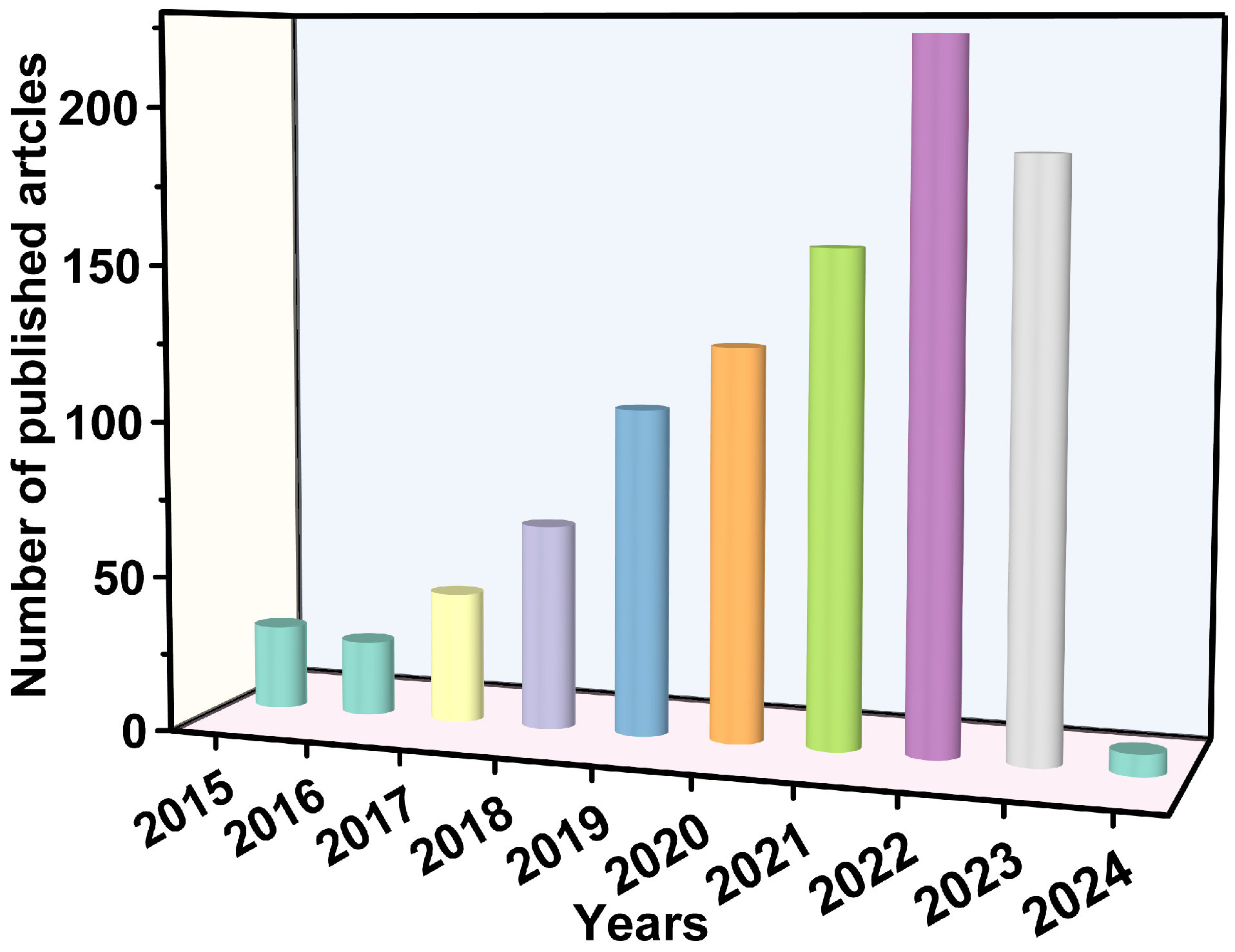


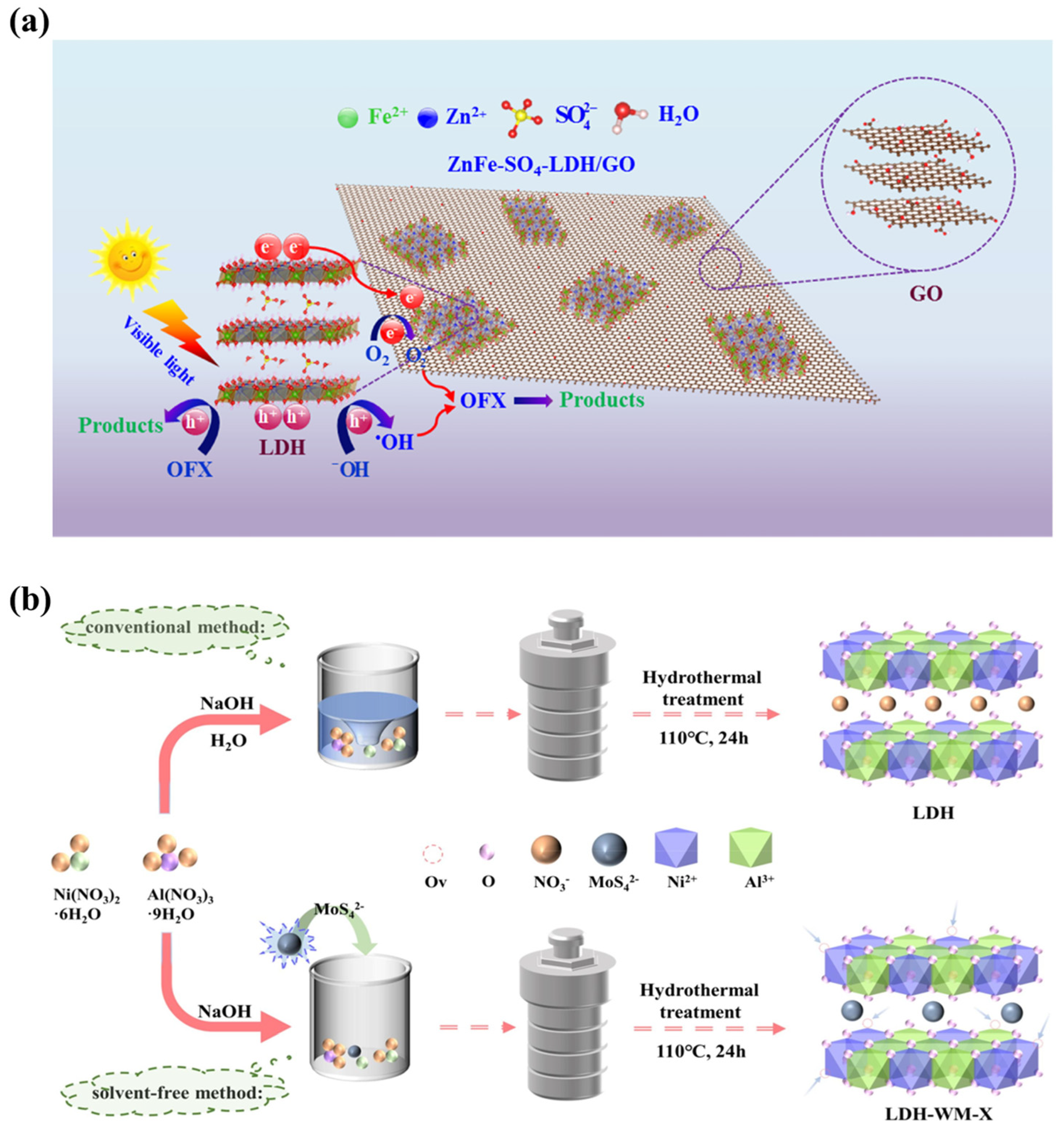

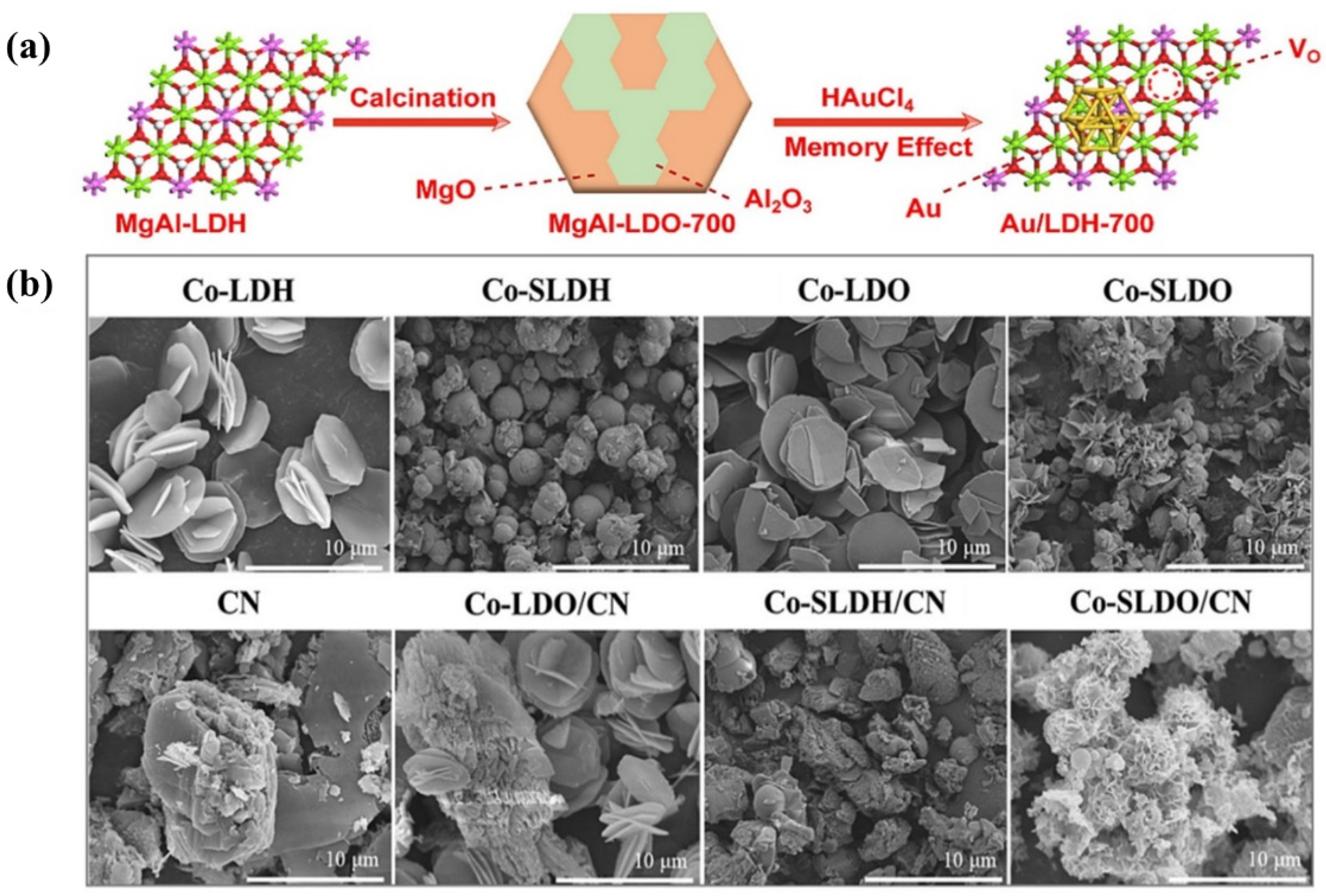
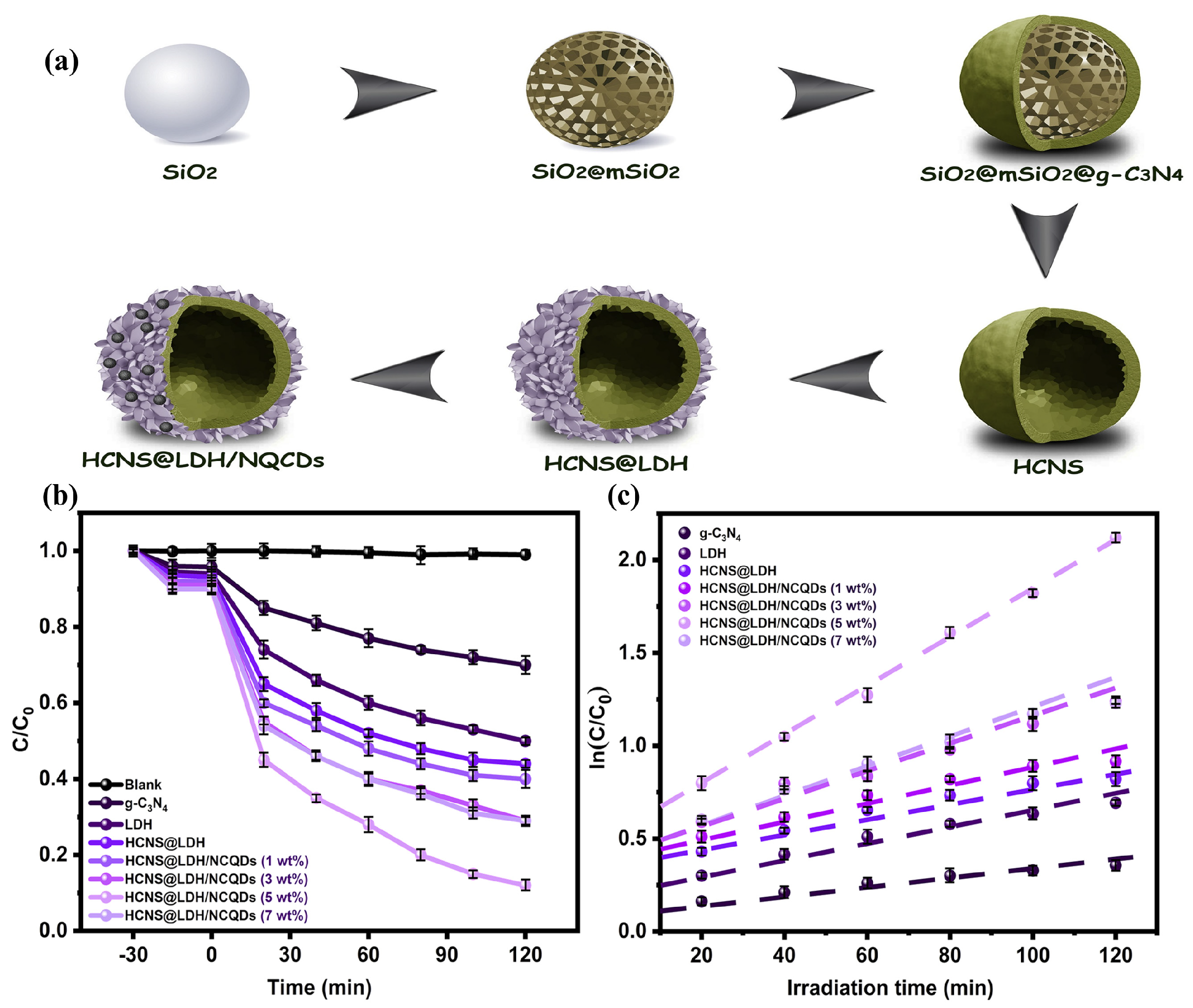
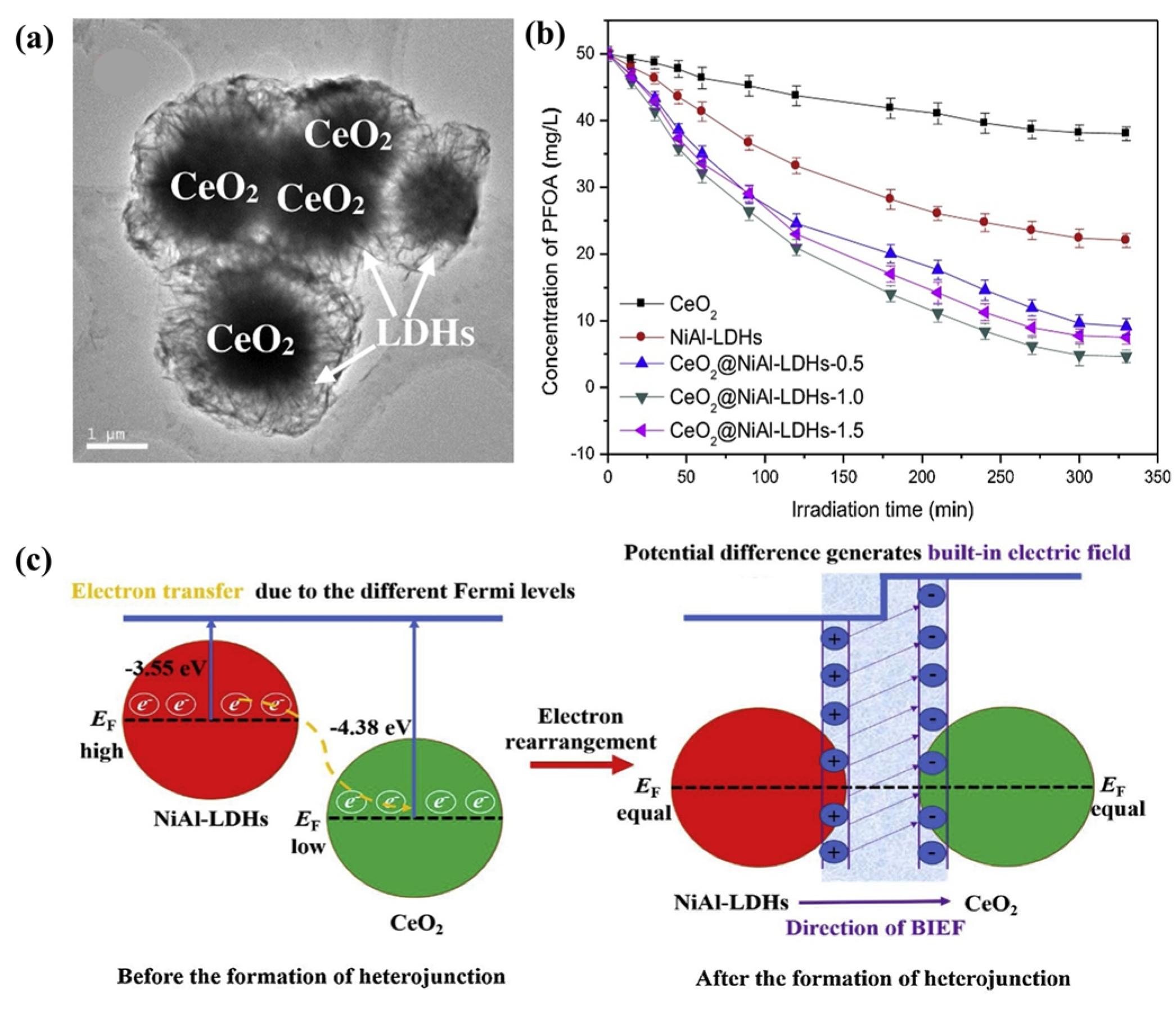


| LDH | Fabrication Method | Condition | Ref. |
|---|---|---|---|
| Mn–doped ZnAl–LDHs | Co-precipitation | 90 °C, 36 h | [42] |
| Ag/Zn–Al LDH | Mechanochemical operation | 1200 rpm, 4 h | [43] |
| ZnNiFe–CO3–LDHs | Complexing agent-assisted homogeneous precipitation technique | 90 °C, 2 days | [44] |
| Mg/Al/Ti–LDH | Co-precipitation | room temperature, 24 h | [45] |
| MgAlSn–LDH | Co-precipitation | 433 K, 36 h | [46] |
| Mn/Co/Ti–LDH | Hydrothermal | 140 °C, 36 h | [47] |
| Co–Al LDH/GO | Co-precipitation | 80 °C, 24 h | [48] |
| Ag@CN–LDH | Hydrothermal treatment | 120 °C, 24 h | [49] |
| Mn/Ti–LDH | Hydrothermal | 140 °C, 48 h | [50] |
| La–doped ZnCr–LDH | Co-precipitation | 160 °C, 24 h | [51] |
| Pt/Zn–Ti–LDHs | Co-precipitation | 100 °C, 24 h | [52] |
| CoAl–LDH/Bi2MoO6 | Hydrothermal | 120 °C, 12 h | [53] |
| CoAl–LDH/g–C3N4 | Hydrothermal | 110 °C, 9 h | [54] |
| Fe3O4@CuCr–LDH | Co-precipitation | 60 °C, 24 h | [55] |
| TMU–5@Ni–Ti–LDH | Hydrothermal | 110 °C, 24 h | [56] |
| g–C3N4/Ce–doped MgAl–LDH | Solvothermal | 160 °C, 6 h | [57] |
| Pollutant | LDH | Degradation Efficiency | Light Irradiation | Ref. |
|---|---|---|---|---|
| Ibuprofen | ZnFe−MMOs | 95.7%, 90 min | 500 W Xe lamp (λ = 300 nm) | [111] |
| Caffeine | ZnO−ZnAl2O4 | 100%, 210 min | UV mercury lamp (400 W) | [105] |
| ACB | ZnAl−LDHs/[FeEDTA] | 97.27%, 180 min | UV light | [84] |
| Caffeine | Ca/ZnO−Al2O3 | 98.5%, 70 min | UV light | [112] |
| SA | ZnTi−LDH | 65%, 6 h | 250 W Xe lamp | [65] |
| Diethyl phthalate | Fe3O4@CuCr−LDH | 70%, 120 min | solar simulator lamp (λ > 400 nm) | [55] |
| TC | In2S3/Zn–Al−LDHs | 92.2%, 30 min | visible light (λ > 400 nm) | [113] |
| BPA | Bi2MoO6/Zn−Al−LDH | 96%, 300 min | visible light | [114] |
| Lomefloxacin | Bi2O3/CuNiFe−LDHs | 84.6%, 40 min | visible light (67 mW/cm2) | [115] |
| CIP | M−RM/LDH | 97.4%, 60 min | visible light (λ = 380–780 nm) | [116] |
| TC | MgAl−LDH/ (BiO)2CO3 | 97.2%, 105 min | visible light | [117] |
| Rifampicin | ZnCr−LDH/rGO | 87.3%, 60 min | LED lamp | [118] |
| BPA | Cu/ZnO/CoFe−CLDH | 80%, 6 h | visible light (λ = 380–780 nm) | [119] |
| Rifampicin | ZnCr LDH/BC | 100%, 40 min | LED lamp | [120] |
| CP | Co−Al−LDH/g−C3N4−CoFe2O4 | 97.2%, 150 min | 50 W LED lamp | [121] |
| NTP | Ag@AgCl/ZnAl−LDH | 100%, 45 min | visible light (780 nm > λ > 420 nm) | [122] |
| NTP | Ag/Ag3PO4/Zn–Al−LDH | 100%, 60 min | visible light (780 nm > λ > 420 nm) | [123] |
| NTP | Bi2WO6/Ag3PO4/Zn−Al−LDH | 100%, 90 min | visible light (780 nm > λ > 420 nm) | [124] |
| NTP | Cu2O/ZnAl−LDH | 78%, 210 min | visible light (λ > 420 nm) | [125] |
Disclaimer/Publisher’s Note: The statements, opinions and data contained in all publications are solely those of the individual author(s) and contributor(s) and not of MDPI and/or the editor(s). MDPI and/or the editor(s) disclaim responsibility for any injury to people or property resulting from any ideas, methods, instructions or products referred to in the content. |
© 2024 by the authors. Licensee MDPI, Basel, Switzerland. This article is an open access article distributed under the terms and conditions of the Creative Commons Attribution (CC BY) license (https://creativecommons.org/licenses/by/4.0/).
Share and Cite
Luo, L.; Hou, C.; Wang, L.; Zhang, W.; Wang, C.; Liu, J.; Wu, Y.; Wang, C. Layered Double Hydroxide-Based Photocatalysts for the Removal of Emerging Contaminants: Progress in Past Ten Years. Catalysts 2024, 14, 252. https://doi.org/10.3390/catal14040252
Luo L, Hou C, Wang L, Zhang W, Wang C, Liu J, Wu Y, Wang C. Layered Double Hydroxide-Based Photocatalysts for the Removal of Emerging Contaminants: Progress in Past Ten Years. Catalysts. 2024; 14(4):252. https://doi.org/10.3390/catal14040252
Chicago/Turabian StyleLuo, Lingfeng, Chen Hou, Lan Wang, Wei Zhang, Cong Wang, Junjie Liu, Yiqian Wu, and Chuanyi Wang. 2024. "Layered Double Hydroxide-Based Photocatalysts for the Removal of Emerging Contaminants: Progress in Past Ten Years" Catalysts 14, no. 4: 252. https://doi.org/10.3390/catal14040252
APA StyleLuo, L., Hou, C., Wang, L., Zhang, W., Wang, C., Liu, J., Wu, Y., & Wang, C. (2024). Layered Double Hydroxide-Based Photocatalysts for the Removal of Emerging Contaminants: Progress in Past Ten Years. Catalysts, 14(4), 252. https://doi.org/10.3390/catal14040252








